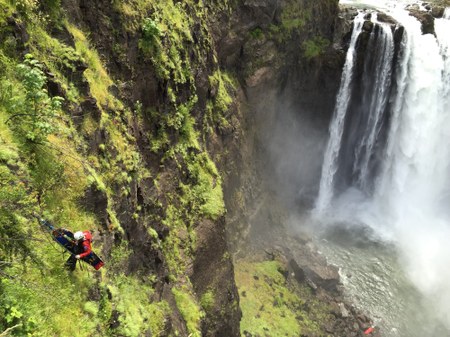
The converted bicycle wheel supports much of the litter’s weight, but this trail is miles of boulders and steep hairpin switchbacks, and the light is fading. In the beginning we tie a piece of webbing to the back of the litter for a tagline; four people hold the litter up and then a half-dozen other people grab onto this piece of webbing to keep the brakeless contraption from rocketing downhill with gravity. Nobody can see their feet, and this trail, like all trails, is too narrow to fit the litter in the middle with two people abreast on either side, so the people on the sides are intermittently mashed into trees, or have no footing and suddenly disappear downslope to be picked up at the next switchback. The folks on the front and back ends do not have a better time.
Finally, one of the medics makes it up to us. We stop, still holding the litter, and cut the man’s shirt off so the medic can get a twelve-lead and defib patches on his chest and hook him up to the monitor that ESAR carried up for them, where we figure out it isn’t a heart attack, but unstable tachycardia, a heart rate fast enough that his heart doesn’t have time to fill with oxygenated blood between contractions. If the heart doesn’t get enough oxygen, heart tissue starts to die and it hurts. The medic tries a few times, but can’t get an IV in, and he says he wants to try to cardiovert: use a medium amount of electricity to shock the man’s heart into a better rhythm.
The medic mutters under his breath, “I don’t want to dick around any longer with pain meds. We need to do this right now.” He looks over at me, “Do we need to set the litter on the ground or is it okay for everyone’s hands to be on it?”
I spend a tenth of a second thinking about aluminum’s conductivity. Yup. It’s conductive. But if I decide to take the wheel off, it’ll take five minutes to get it off and then put it back on again.
All my friends look up at me very seriously. I figure that it’s unlikely he’s really touching the rail, since we’ve got a pad under him and he’s mostly in a sleeping bag.
“Go for it,” I tell the medic. No one else says anything, and it’s suddenly very quiet.
We’re making just a little pool of bluish headlamp light in the dark. McCall is holding the monitor and I’ve got all the paraphernalia from the IV attempts in both hands, so neither of us is holding the litter. Both of us are standing a little bit behind the medic, where he can’t see us, but everyone holding onto the litter can.
The medic leans over the man and says, “Sorry, man, this is going to hurt like an f-ing mother,” and then he dials it up, and says “All clear.” My friends are not all clear, but the irony of this statement is lost on the medic.
Larry is standing across from us, holding onto the aluminum litter rail, and together McCall and I smile at him with wide evil smiles while he glares at us, and then the medic pushes the shock button. The man’s whole body launches vertically, and he screams once, a release of air and agony. He crashes down again and a second later, when we’re all looking at the monitor, the man suddenly clears his throat and says, “Wow, that’s so much better.” But the medic looks at the monitor again and says “Yeah, so I’m still not happy. We’re going to do this one more time.” And he bumps the dial up 50 joules.
Neither McCall nor I look at Larry. Larry won’t make eye contact with me, and gives no hint of whether that was painful or not. He didn’t let go of the rail the first time though, and I figure that’s good enough to keep going with this plan.
The medic hits the button again.
This excerpt has been edited for space from Found: A Life in Mountain Rescue.
This article originally appeared in our Spring 2017 issue of Mountaineer Magazine. To view the original article in magazine form and read more stories from our publication, click here.
 Bree Loewen
Bree Loewen